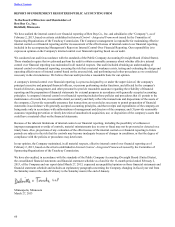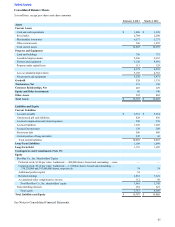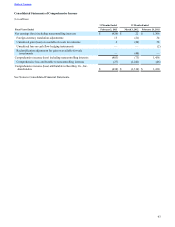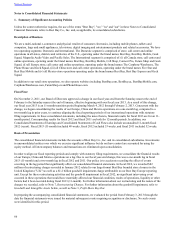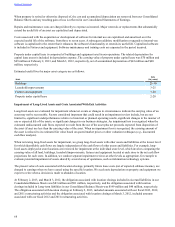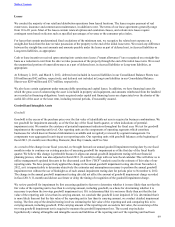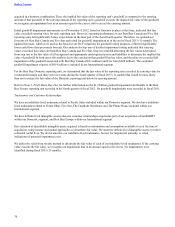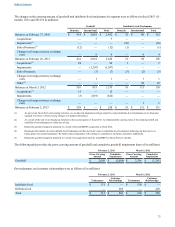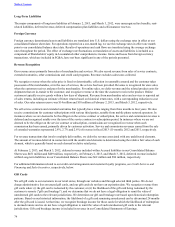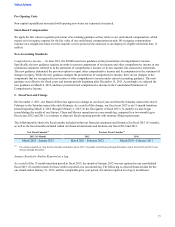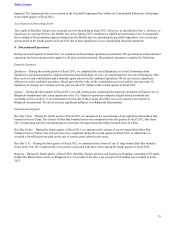Best Buy 2013 Annual Report Download - page 69
Download and view the complete annual report
Please find page 69 of the 2013 Best Buy annual report below. You can navigate through the pages in the report by either clicking on the pages listed below, or by using the keyword search tool below to find specific information within the annual report.
69
Leases
We conduct the majority of our retail and distribution operations from leased locations. The leases require payment of real
estate taxes, insurance and common area maintenance, in addition to rent. The terms of our lease agreements generally range
from 10 to 20 years. Most of the leases contain renewal options and escalation clauses, and certain store leases require
contingent rents based on factors such as specified percentages of revenue or the consumer price index.
For leases that contain predetermined fixed escalations of the minimum rent, we recognize the related rent expense on a
straight-line basis from the date we take possession of the property to the end of the initial lease term. We record any difference
between the straight-line rent amounts and amounts payable under the leases as part of deferred rent, in Accrued liabilities or
Long-term liabilities, as appropriate.
Cash or lease incentives received upon entering into certain store leases ("tenant allowances") are recognized on a straight-line
basis as a reduction to rent from the date we take possession of the property through the end of the initial lease term. We record
the unamortized portion of tenant allowances as a part of deferred rent, in Accrued liabilities or Long-term liabilities, as
appropriate.
At February 2, 2013, and March 3, 2012, deferred rent included in Accrued liabilities in our Consolidated Balance Sheets was
$50 million and $42 million, respectively, and deferred rent included in Long-term liabilities in our Consolidated Balance
Sheets was $289 million and $317 million, respectively.
We also lease certain equipment under noncancelable operating and capital leases. In addition, we have financing leases for
which the gross cost of constructing the asset is included in property and equipment, and amounts reimbursed from the landlord
are recorded as financing obligations. Assets acquired under capital and financing leases are depreciated over the shorter of the
useful life of the asset or the lease term, including renewal periods, if reasonably assured.
Goodwill and Intangible Assets
Goodwill
Goodwill is the excess of the purchase price over the fair value of identifiable net assets acquired in business combinations. We
test goodwill for impairment annually, as of the first day of the fiscal fourth quarter, or when indications of potential
impairment exist. We monitor the existence of potential impairment indicators throughout the fiscal year. We test for goodwill
impairment at the reporting unit level. Our reporting units are the components of operating segments which constitute
businesses for which discrete financial information is available and is regularly reviewed by segment management. No
components were aggregated in arriving at our reporting units. Our reporting units with goodwill balances at the beginning of
fiscal 2013 (11-month) were Best Buy Domestic, Best Buy Canada, and Five Star.
As a result of the change in our fiscal year-end, we brought forward our annual goodwill impairment testing date by one fiscal
month in order to continue our existing practice of assessing goodwill for impairment as of the first day of the fiscal fourth
quarter. We believe this change is preferable because it aligns our annual goodwill impairment testing with our financial
planning process, which was also adjusted in fiscal 2013 (11-month) to align with our new fiscal calendar. This will allow us to
utilize management's updated forecasts in the discounted cash flow ("DCF") analysis used in the estimate of fair value of our
reporting units. We have prospectively applied the change in the annual goodwill impairment testing date from November 4,
2012, as it is impracticable to determine objectively the estimates and assumptions necessary to perform the annual goodwill
impairment test without the use of hindsight as of each annual impairment testing date for periods prior to November 4, 2012.
The change in the annual goodwill impairment testing date did not affect the amount of goodwill impairment charge recorded
in fiscal 2013 (11-month) and did not accelerate or delay the timing of recognition of the goodwill impairment charge.
We review goodwill for impairment by first assessing qualitative factors to determine whether it is more likely than not that the
fair value of the reporting unit is less than its carrying amount, including goodwill, as a basis for determining whether it is
necessary to perform the two-step goodwill impairment test. If it is determined that it is not more likely than not that the fair
value of the reporting unit is less than its carrying amount, we conclude that goodwill is not impaired. If it is determined that it
is more likely than not that the fair value of the reporting unit is less than its carrying amount, we conduct detailed impairment
testing. The first step of the detailed testing involves estimating the fair value of the reporting unit and comparing this to its
carrying amount, including goodwill. If the carrying amount of the reporting unit exceeds its fair value, the second step of the
two-step goodwill impairment test is required to measure the goodwill impairment loss. The second step includes
hypothetically valuing all tangible and intangible assets and liabilities of the reporting unit as if the reporting unit had been
Table of Contents



